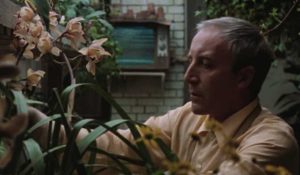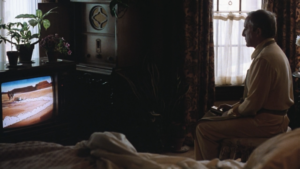Attend: Program Notes
Being There | Hal Ashby | United States | 1979 | 130 min.
Cinesthesia, Madison Public Library Central Branch, Thursday, December 6, 6:30 p.m.»
A stately satire of modern media consumption and American politics, Hal Ashby’s Being There feels more prescient than ever.
“The emergence of celebrity in America is not based on depth,” Jerzy Kosinski, author of the 1971 novel Being There, states. “It is based on visibility and accessibility, a smile, a figure. It is based on appearing as a man of importance. The question asked is not ‘Is he a good man?’ It’s ‘What circles does he move in?’”

Hal Ashby’s adaptation of Kosinki’s seminal book captures the spirit of the 1970s, while conveying the power of images in our increasingly technological consumer society. At once a provocative look at the unreality of American media culture, a brilliant political satire, a modern parable about the nature of identity in the information age, and a bizarre story of chance, Being There feels more relevant than ever.
In his last great performance, Peter Sellers plays Chance, a childlike, simple-minded gardener who has spent his entire life in the high-walled estate of a wealthy, reclusive benefactor. His only knowledge of the outside world comes from watching television and his meals have always been produced by Louise, the cook (Ruth Attaway). When his guardian dies, the illiterate Chance suddenly finds himself thrust into the streets of Washington, D.C., with no birth certificate, driver’s license, checkbook or medical records.
Well-groomed and impeccably dressed in an elegant, secondhand tailored suit, Chance knows how to comport himself by imitating what he has seen on TV. As he aimlessly wanders around, a happy accident brings him into contact with Eve (Shirley MacLaine), the much younger wife of Benjamin Rand (Melvyn Douglas), a rich, powerful, and ailing industrialist. Assuming Chance the gardener to be an aristocratic businessman named “Chauncey Gardiner,” Eve invites him into their home and therefore into their lives.
With one foot in the grave, Benjamin immediately feels an affinity for this calm, reassuring, and enigmatic visitor, whose vacuous remarks are misinterpreted as astute observations on life and politics. When the President of the United States (Jack Warden) stops by, Benjamin introduces him to his new friend, who naïvely addresses the Chief Executive by his first name and makes an impression on him. Chance unwittingly becomes a presidential policy adviser and a media icon, appearing on talk shows, attending important functions, and establishing a close rapport with the Soviet ambassador. In no time, Chance rises to national prominence, despite seeming to have never existed prior to meeting the Rands.
Journalist and film historian Mark Harris, in his essay on Being There for the Criterion Collection, writes,
Who is Chance? In the cultural syntax of Kosinski’s work, he is a kind of holy fool, a man who knows nothing yet knows everything, a popular mystical/sentimental trope of the time. In contemporary diagnostic terms, he would be considered to lie somewhere on the autism spectrum. Cultural moralists labeled him the ominous end point of what was, at the time, referred to as “the television generation”—an incarnation of stoic passivity who can express almost no preference other than “I like to watch.” In Sellers’s determinedly controlled, virtually affectless performance, he is all those things and more, and also less—a blank slate, an emotional dead spot, the eternal “little boy” his late benefactor’s caregiver calls him, and also, in a very quiet way, a clown.
In his outstanding, thoroughly researched biography, Being Hal Ashby: Life of a Hollywood Rebel, Nick Dawson notes that Peter Sellers brought Kosinski’s novel to Ashby in 1973, soon after Ashby had finished directing Jack Nicholson in The Last Detail. “When I read Being There, I was crazy about it,” Sellers said. “I had just seen Harold and Maude, which I thought was sensational, so I rushed a copy of the book to Ashby.” Sellers considered himself ideal for the character of Chance. The actor once told film critic Roger Ebert he had “absolutely no personality at all. I am a chameleon. When I am not playing a role, I am nobody.”
Ashby was intrigued by Sellers’s pitch for Being There and liked the idea of working with him. However, at the time, Sellers’s career was in a slump and neither he nor Ashby was in a position to raise enough money to make the film. Being There lay dormant for five years until producer Andrew Braunsberg, unaware of the history of the project, approached Ashby to direct it. Ashby said, “Absolutely. But I wouldn’t do it with anybody but Peter Sellers.” Ryan O’Neal (Barry Lyndon) was Kosinski’s choice, and Braunsberg too was skeptical that Sellers—a corpulent, aging comic actor without significant box-office influence—was right for the role. He finally had a facelift to look the part and his casting was approved.
Yet, just days before shooting was to begin, Sellers underwent a crisis of confidence, suddenly doubting his ability to portray Chance. He had never thought about precisely how he would play the part and now frantically searched for the two elements that would define the character: Chance’s walk and most important, his voice. Working alone with a tape recorder, then with his wife, Lynne Frederick, and with Ashby, Sellers perfected Chance’s speech, a mid-Atlantic accent, clear enunciation, and a flat delivery.

Sellers completely withdrew into the persona of Chance the gardener. He described the experience of working on Being There as “so humbling, so powerful,” and would sometimes call “Cut!” in the middle of a scene because he was overwhelmed. When asked if he was all right, he would answer in a bewildered way, “Oh. No, no. I’ve just never seen anything quite like this film before.” Once a scene was over, he would more often than not silently retreat to his trailer so as not to lose his connection with Chance. The actor refused most interview requests and kept his distance from MacLaine, who complained about him going off into a corner. Even when he returned home to his wife, he usually remained in character.
Kosinski, who had written a screenplay of the novel back in 1971, was hired to adapt Being There. Ashby later said that Kosinski’s own script was “too heavy-handed” for his taste. So, Ashby gave the book and Kosinski’s screenplay to Robert C. Jones, who rewrote it extensively. For the most part, the film remains faithful to the book. Jones wrote an alternate ending in which Chance leaves the funeral, and Eve goes after him. As he uses his umbrella as a windscreen to protect a tree, Eve says, “Where were you? I was looking for you.” And he replies, “I was looking for you, too, Eve.” Instead, Ashby concludes the film on a note of whimsy that he thought up during production. MacLaine, among others, disliked the final image.
Regarded as Ashby’s masterpiece, Being There exemplifies the maverick director’s offbeat sense of humor, optimistic outlook on life, freewheeling approach to filmmaking, and deep-rooted humanism. “There’s no story line or anything like that running through my pictures,” Ashby told film historian Joseph McBride in 1976, “but I try to do films that deal with human relations, with people relating to one another.” While it has been called a “one-joke film,” Being There finds its tone and stays with it. Sellers’s carefully nuanced, low-key performance brings Chance’s aloof innocence to life as Ashby’s gently assured direction realizes the absurdist comedy of the film’s premise with warmth and sensitivity. “The timing is often so perfect that the film, at its very wittiest, strips conversation down to its barest maneuvers and stratagems,” Janet Maslin observes in her 1979 New York Times review of Being There.
A hilarious portrait of a man living in the immediate present, who relates to no one but to whom everyone relates, Being There ultimately reveals something darker and deeper beneath its placid surface. If Chance’s empty-headed pronouncements indicate how superficial public speech can be, then his reception tells us even more. Because he happens to be a white, middle-aged, well-spoken man with an attractive outward appearance and influential friends, Chance inadvertently achieves miraculous success in the world. People mistake his social ineptitude and directness for eccentricity and self-confidence. Although he can neither read nor write, the Soviet ambassador admires him for his deep appreciation of Russian literature, and a book publisher offers Chance an advance on a manuscript. By the end of the film, he is being seriously proposed as a candidate for office. In the words of Mark Harris,
We invest people with unspeakable power by reinventing them as reflections of our hopes and our vanities, and it is thus terrifyingly possible for us to endow a complete imbecile who watches TV all day with qualities he has never possessed. This idea will never go out of style; as a cautionary tale, Being There is elastic enough to feel as if it is perpetually about our moment, as long as our moment includes campaigns, elections, and politicians. (In 1980, as the film went into wide release, many commentators saw it as a prescient take on the rise of Ronald Reagan.)
In a high-tech, post-truth cultural landscape saturated with images, Ashby’s stately satire of modern media consumption and American politics continues to resonate with our ideals and anxieties. “Of course, today the film’s worst-case scenario looks nostalgically benign,” critic and filmmaker David Cairns remarks. Nevertheless, the enduring appeal of Being There derives not only from its foresight or the acuity of its observations. The much-discussed final sequence of the film compels us to rethink our assumptions about Chance and leaves Being There open to many different interpretations. Functioning as a blank screen on which people project their expectations, Chance effectively becomes a continuous flow of mutable images, just like a television set. While the audience may take his actual disposition for granted, things are not always what they seem (especially in a movie about the pliability of perception). At last, Being There presents viewers with a lingering image that remains as fundamentally unknowable as any other. After all, as the president asserts during his eulogy for Ben Rand, “Life is a state of mind.” 